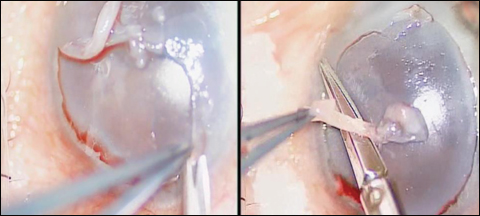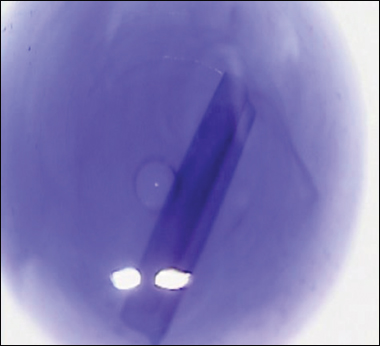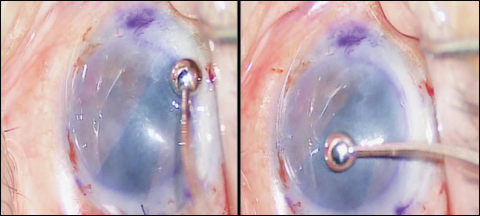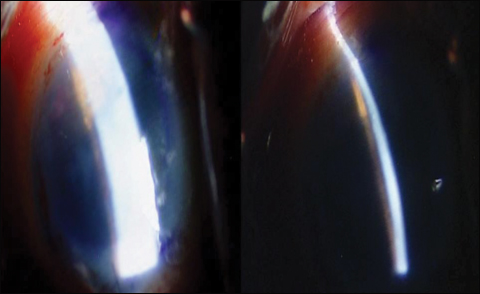Intraoperative slit lamp improves visualization of anterior chamber through cloudy cornea in DMEK
Adequate visualization of the anterior chamber is imperative to recognize the donor tissue orientation of the surface with healthy endothelial cells.

Endothelial keratoplasty has revolutionized corneal transplantation with the elimination of full-thickness corneal wounds and suture reduction to a single suture for the temporal corneal wound. Such advancement was possible because of the air bubble-assisted attachment of the donor corneal tissue to the recipient inner corneal stromal surface without the need for corneal sutures. Currently, Descemet’s membrane endothelial keratoplasty has been of great interest to corneal surgeons globally. Further, eye banks have been involved with donor tissue that is ready to use in the operating room, thus simplifying the surgical steps for corneal surgeons in performing endothelial keratoplasty. Industry involvement with improved surgical instruments, partial-thickness trephines and donor tissue delivery systems to introduce the donor corneal disc into the recipient anterior chamber has also assisted and refined surgical techniques, all of which translates into improved postoperative outcomes, augmented visual quality and faster visual recovery for our patients who undergo endothelial keratoplasty.
The future of corneal transplantation is also bright, with in vitro tissue-engineered expansion of donor endothelial cells, pure donor endothelial cell transplantation via injection conduit, and also chemically induced augmentation of existing endothelial cells within the patient’s cornea. Thus, the combined efforts of researchers, corneal surgeons, eye banks and industry all amalgamate and translate into taking modern day corneal transplantation to yet another level of sophistication and improved visual quality.
In this column, I describe removal of hyperplastic thickened corneal epithelium combined with the use of intraoperative slit lamp to improve visualization of the recipient anterior chamber during DMEK surgery.

Images: John T





Technique
Endothelial keratoplasty is performed in cases of endothelial decompensation contributing to a cloudy cornea with compromised vision causing interference with the patient’s daily activities. The cloudy cornea is primarily due to corneal stromal edema. However, over the course of time, epithelial edema, bullae formation and formation of a hyperplastic, highly thickened corneal epithelium with a very irregular surface prevent proper visualization of the anterior chamber during endothelial keratoplasty. Adequate visualization of the anterior chamber is imperative to recognize the donor tissue orientation of the surface with healthy endothelial cells. To improve visualization of the anterior chamber in this very cloudy cornea, the loosely adherent epithelium is detached from the underlying cornea with a dry Weck-Cel spear, the distal blade of smooth tying forceps is slid within the epithelial-Bowman’s layer interface, and the sheet of highly thickened epithelium is lifted as a single sheet from the corneal surface (Figure 1).
Following detachment of the loosely adherent epithelium from the underlying intact Bowman’s layer, the epithelium is lifted with 0.12 forceps and the thickened epithelial sheet is excised using Vannas scissors, leaving the peripheral epithelium intact with its stem cells (Figure 2). An 8-mm DMEK ring marker highlighted with methylene blue is imprinted on the de-epithelialized corneal surface. The John Dexatome (Bausch + Lomb) is used to perform descemetorhexis and detachment of the disc of Descemet’s membrane with its decompensated endothelial cells. The tip of the John Dexatome touches the folded recipient Descemet’s membrane, thus keeping the inner stromal surface of the recipient cornea pristine and not damaged by the instrument tip (Figure 3). The recipient Descemet’s membrane with its endothelium is detached as a single disc and removed from the recipient anterior chamber via the peripheral stab incision in the cornea (Figure 3). Thus, no islands of Descemet’s membrane are left behind within the central region of the recipient cornea.
Donor Descemet’s membrane with its healthy corneal endothelial cells is stained with trypan blue before delivery into the recipient anterior chamber (Figure 4). Next, the John DMEK Smoother (Bausch + Lomb) is used to unscroll the donor Descemet’s membrane with the healthy corneal endothelium within the recipient anterior chamber (Figure 5). The John DMEK Smoother is also helpful in centering the donor Descemet’s membrane disc to the circular mark on the corneal surface. An intraoperative broad-beam slit lamp view of the anterior chamber through a cloudy cornea improves visualization of the anterior chamber and the donor scroll of Descemet’s membrane with healthy donor endothelial cells that have been stained with trypan blue. Without the slit lamp, the view of the anterior chamber in this case is highly compromised (Figure 6). A narrow-beam slit lamp view also clearly visualizes the anterior chamber and facilitates identification of the donor tissue orientation to help proper unscrolling and attaching the donor disc to the recipient cornea (Figure 6).
The use of intraoperative slit lamp clearly improves visualization via a cloudy cornea in DMEK surgery. Complementary technology that can also help in augmented visualization of the recipient anterior chamber includes intraoperative OCT.
- References:
- Ham L, et al. Am J Ophthalmol. 2016;doi:10.1016/j.ajo.2016.08.038.
- John T, ed. Endothelial Transplant, DSAEK, DMEK, & DLEK. Jaypee-Highlights Medical Publishers Inc.; 2010.
- John T, ed. Lamellar Corneal Surgery. New York: McGraw-Hill Companies; 2008.
- John T, ed. Surgical Techniques in Anterior and Posterior Lamellar Keratoplasty. Jaypee Brothers Medical Publishers Ltd.; 2006.
- Price FW Jr, et al. Cornea. 2013;doi:10.1097/ICO.0b013e3182a0a307.
- Steven P, et al. JAMA Ophthalmol. 2013;doi:10.1001/jamaophthalmol.2013.4672.
- For more information:
- Thomas “TJ” John, MD, is a clinical associate professor at Loyola University at Chicago and in private practice in Oak Brook, Tinley Park and Oak Lawn, Ill. He can be reached at tjcornea@gmail.com.
Disclosure: John reports he is a consultant to Bausch + Lomb.
